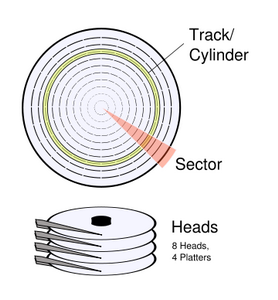Data Storage
Part 2 - Storage Basics
Data is organized on Media in 2 ways. The physical Storage, and the Logical Storage as controlled by the filesystem.
Layout of Data

Tracks are the circular rings on the disk platter. Tracks are also known as cylinder
Sectors are the basic physical storage Divisions on a Disk that are in Pie Shaped Wedges, from the Centre to the outside. The Sector Size is based on the Block size a Sector usees on each track. Today this number is still 512 Bytes
Clusters are the logical storage units on storage devices as defined by the Filesystems. Clusters will always be sized based on Sectors. In fact A Cluster is usually X number of Sectors, and X is always a Power of 2 (ie 1, 2, 4, 8, 16, 32, 64, etc.).
Addressing of Data
cylinder-head-sector - CHS - was the type of Addressing used in old Hard drives, using 20-bits based on the physical number of Cylinders (or trakcs), the nubmber of Disk Heads, and the number of Sectors per Track/Cylinder. The values were Limited to 1024, 16, and 63, resulting in only 1,032,192 blocks of 512K. This limited Hard Drive sizes to 504 MB
Extended CHS - ECHS - Was a 24-bit Addressing introduced to combat the Limitations of CHS. The number no longer were representative of the Physical layout of the Disk, rather a virtul representation. The 4-bits were used to increase the number of Heads from 16 to 255, rusulting in 16,450,560 Blocks, and thus A Drive size limit of 8032.5 MB (7.8 GB)
Logical block addressing - LBA is the common scheme used for specifying the location of blocks of data,
- ECHS - 24-bit Was the Initial implementation in ATA-2, allowed for drive sizes up to (7.8 GB)
- 28-bit LBA was introduced along with ATA-3 in order to allow for drives up to 128 Gigabytes in size
- 32-bit LBA is used by SCSI Devices, allows for up to 2 Terabytes of addressable Storage
- 48-bit LBA introduced along with ATA-6 Increased the addressable size of drives to a huge 128 Petabytes. Each Petabyte is 1,048,576 Gigabytes!!!
|

